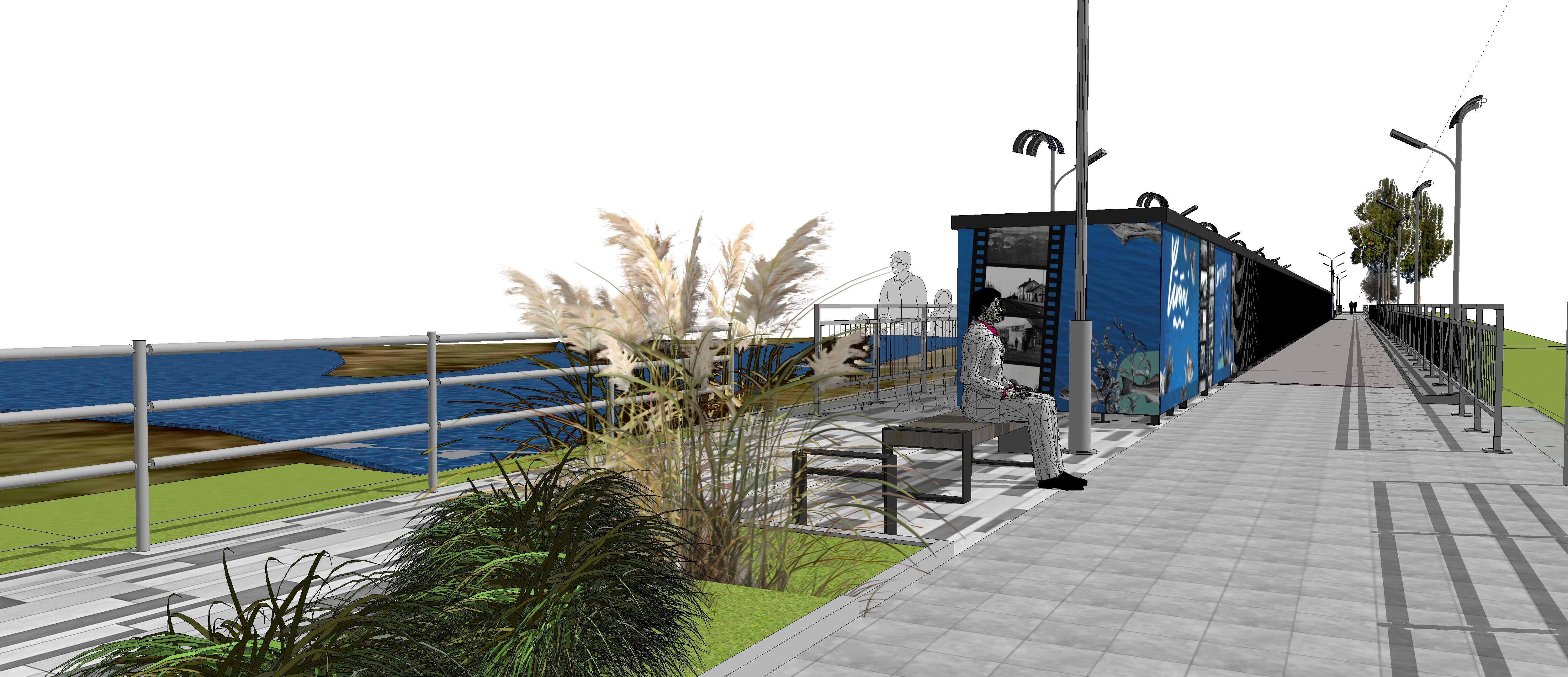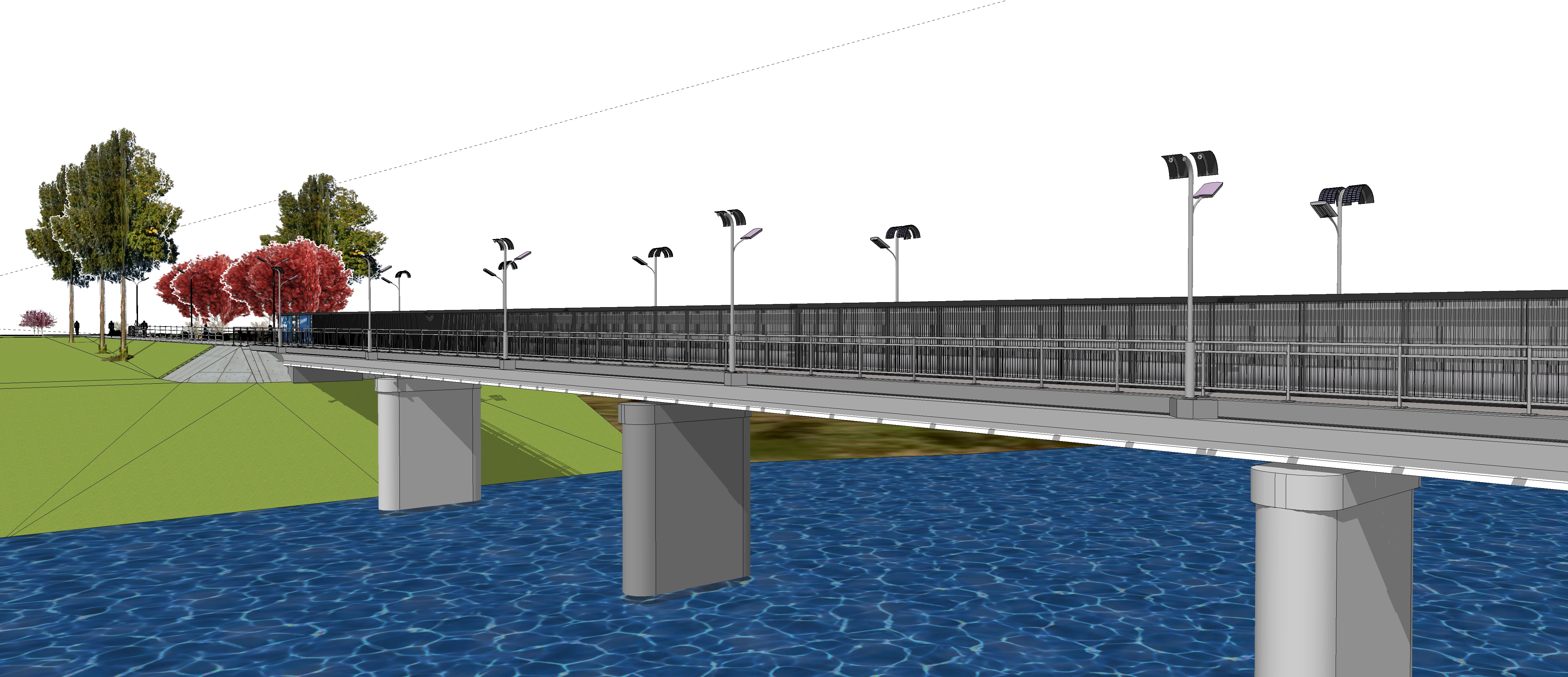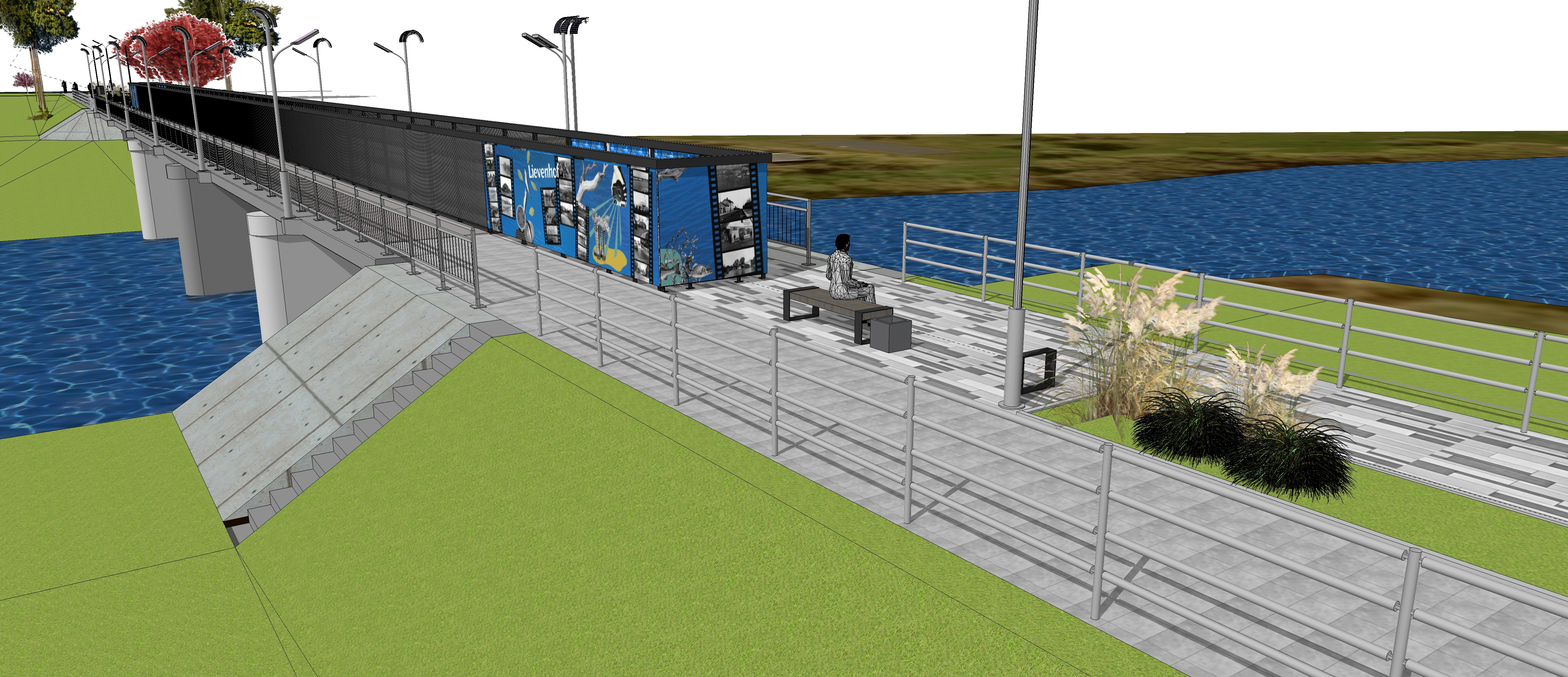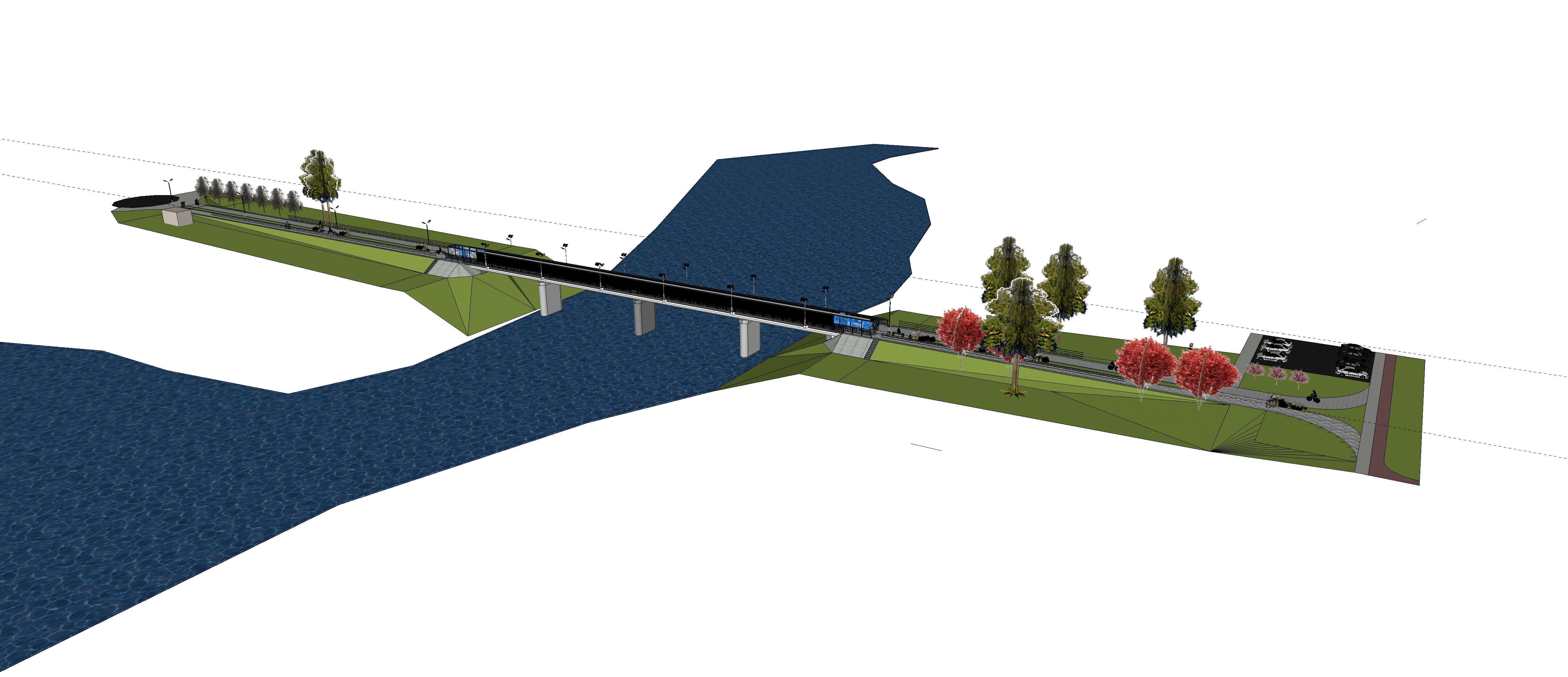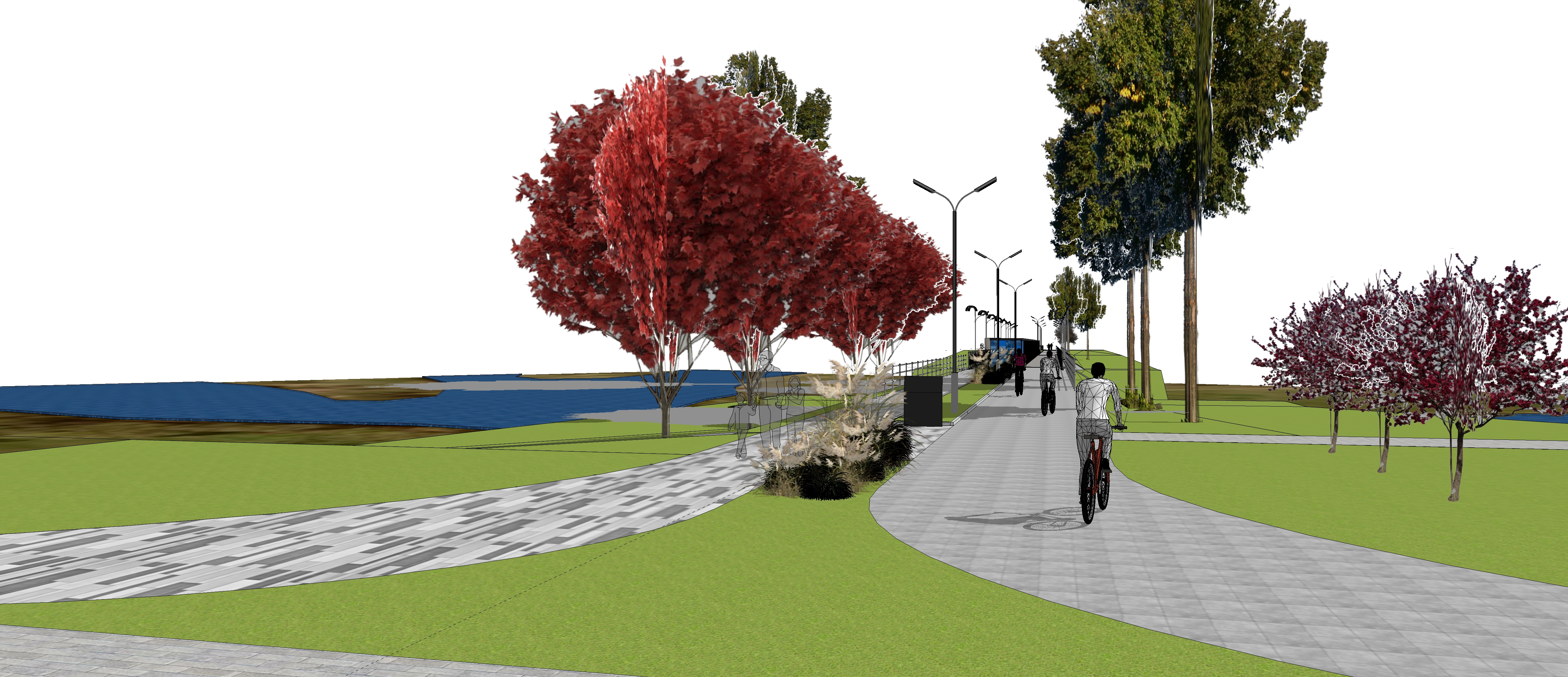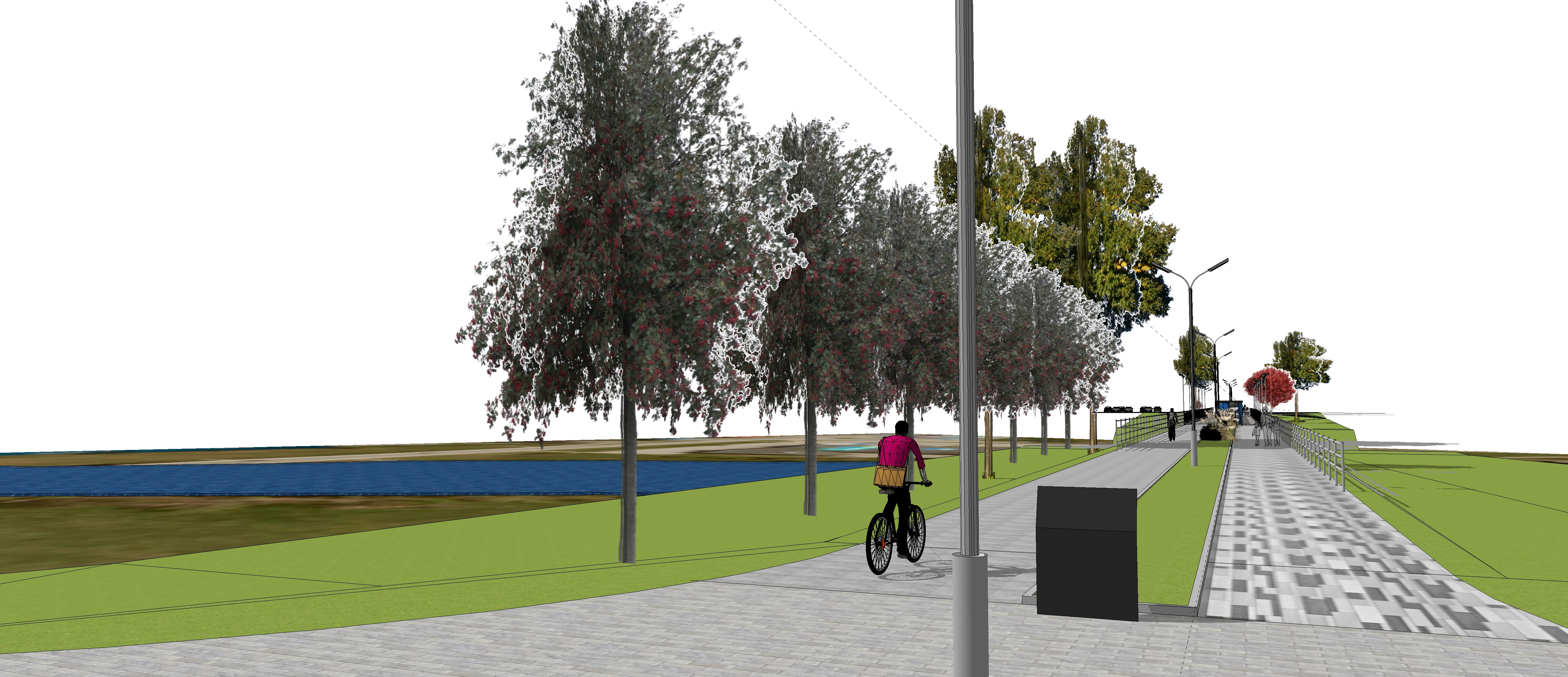Beyond the Bridge of Remembrance
{Empty}
The aim of the project is to renovate the pedestrian bridge over the Dubna River and improve the adjacent territory, ensuring the safety and comfort of pedestrians and visitors in the Livani district. This project aligns with the principles of functional and sustainable urban development, promoting green tourism and creating an environment that fosters a strong connection to the Bauhaus movement.
Latvia
4B Domes Street, Livani, LV-5316, Latvia.
Cadastre number - 76110050013
Cadastre number - 76110050013
Prototype level
Yes
Yes
Yes
Yes
ERDF : European Regional Development Fund
5.1.1.3 Public Space Development
Submission Deadline
25.07.2023 - 01.12.2023
Submission Deadline
25.07.2023 - 01.12.2023
No
0036000: Livanu novads (LV)
Livani, a charming European town with a population of fewer than 10,000 people, holds a remarkable legacy that is uniquely intertwined with the world. Since the 19th century, this small town has been a center of glass production, and today, it stands as the heart of Europe’s fiber optic industry. In a town of this size, two world-class companies collaborate with some of the globe’s leading medical corporations, playing a pivotal role in shaping the future.
At the heart of Livani’s rejuvenation and its ongoing legacy is a symbol of connection and unity: the Livani pedestrian and cyclist bridge. This bridge, which spans the two riverbanks of the city, is not merely a functional passage—it is a bridge between eras. As part of its restoration, it will come alive with a vibrant tapestry of historical and modern photographs. These images will celebrate Livani's rich history, from the bustling glass factory of the 19th century to the dynamic fiber optic industry of today. They will narrate stories of people, nature, and culture, capturing the rhythms of everyday life, the changing seasons, and the enduring beauty of the rivers that have shaped this land.
The bridge will transcend its architectural function, becoming a symbol of the harmonious interaction between humanity and nature, of sustainable coexistence across generations. It will evoke the deep connection between the past, present, and future, where the images of the 19th, 20th, and 21st centuries converge, telling the story of a town’s evolution through the eyes of local photographers.
But more than a simple monument to the passage "The overall aim of the project is to renovate the pedestrian bridge over the Dubna River and enhance the surrounding area, ensuring the safety and comfort of Livani's residents and visitors. This initiative will promote green tourism and contribute to the functional and sustainable urban development of the neighborhood, benefiting both local citizens and those visiting the district."
At the heart of Livani’s rejuvenation and its ongoing legacy is a symbol of connection and unity: the Livani pedestrian and cyclist bridge. This bridge, which spans the two riverbanks of the city, is not merely a functional passage—it is a bridge between eras. As part of its restoration, it will come alive with a vibrant tapestry of historical and modern photographs. These images will celebrate Livani's rich history, from the bustling glass factory of the 19th century to the dynamic fiber optic industry of today. They will narrate stories of people, nature, and culture, capturing the rhythms of everyday life, the changing seasons, and the enduring beauty of the rivers that have shaped this land.
The bridge will transcend its architectural function, becoming a symbol of the harmonious interaction between humanity and nature, of sustainable coexistence across generations. It will evoke the deep connection between the past, present, and future, where the images of the 19th, 20th, and 21st centuries converge, telling the story of a town’s evolution through the eyes of local photographers.
But more than a simple monument to the passage "The overall aim of the project is to renovate the pedestrian bridge over the Dubna River and enhance the surrounding area, ensuring the safety and comfort of Livani's residents and visitors. This initiative will promote green tourism and contribute to the functional and sustainable urban development of the neighborhood, benefiting both local citizens and those visiting the district."
Renovation
Sustainability
Green Tourism
Safety
Community
The goal of this project is to renovate the pedestrian bridge over the Dubna River and enhance the surrounding area, ensuring the safety and comfort of pedestrians, residents, and visitors to the Livani Region. By promoting green tourism, functional urban development, and sustainability, this initiative will significantly contribute to the region's growth.
Upon completion, the project will create a vibrant public open space within the heart of Livani, focusing on the pedestrian bridge—a key landmark in the city. This strategic investment aims to maximize returns by improving public safety, increasing opportunities for outdoor recreation, and enriching the quality of life in the urban environment, especially for families in the Livani Region.As the city continues to develop, several important institutions are located on both banks of the Dubna River. On the right bank, you'll find the Livani 1st Secondary School, while the left bank is home to the “Laimiņas” branch, Livani Hospital, the Livani Swimming Pool "Upe," the Livani Municipality, and the SIA Ceram Optec enterprise. The bridge provides easy access to these key destinations, enhancing connectivity and convenience for residents. This picturesque spot not only serves the daily needs of Livani’s residents but also attracts tourists and visitors from outside the region. It has become one of the area's notable attractions, particularly for active cyclists and sports enthusiasts who use the bridge to access their favorite destinations.The nearby Livani Regional Main Library is also within easy reach. The bridge’s strategic location allows residents to bypass central city traffic while enjoying stunning views of the Livani City Road Bridge and the Mezhrozites Hydroelectric Power Station.
Through this project, the pedestrian bridge will evolve into a more functional, accessible, and welcoming space, contributing to the broader goal of creating a sustainable and vibrant urban environment in the Livani Region.
Upon completion, the project will create a vibrant public open space within the heart of Livani, focusing on the pedestrian bridge—a key landmark in the city. This strategic investment aims to maximize returns by improving public safety, increasing opportunities for outdoor recreation, and enriching the quality of life in the urban environment, especially for families in the Livani Region.As the city continues to develop, several important institutions are located on both banks of the Dubna River. On the right bank, you'll find the Livani 1st Secondary School, while the left bank is home to the “Laimiņas” branch, Livani Hospital, the Livani Swimming Pool "Upe," the Livani Municipality, and the SIA Ceram Optec enterprise. The bridge provides easy access to these key destinations, enhancing connectivity and convenience for residents. This picturesque spot not only serves the daily needs of Livani’s residents but also attracts tourists and visitors from outside the region. It has become one of the area's notable attractions, particularly for active cyclists and sports enthusiasts who use the bridge to access their favorite destinations.The nearby Livani Regional Main Library is also within easy reach. The bridge’s strategic location allows residents to bypass central city traffic while enjoying stunning views of the Livani City Road Bridge and the Mezhrozites Hydroelectric Power Station.
Through this project, the pedestrian bridge will evolve into a more functional, accessible, and welcoming space, contributing to the broader goal of creating a sustainable and vibrant urban environment in the Livani Region.
An educational stand, designed in the form of the river, will be installed to offer visitors a deeper understanding of the area’s natural and cultural significance. By presenting historical information, local landscape values, and natural highlights, the stand will educate and engage both residents and visitors. This creates an immersive experience that blends learning with leisure, enriching the cultural and educational fabric of the region. Every aspect of the design, from the scenic benches to the artistic elements, aims to foster positive emotions. The combination of nature, art, and community-focused spaces creates an atmosphere where visitors feel connected to both the environment and the people around them. The presence of green spaces, inviting views, and thoughtful details encourages feelings of peace and well-being.n the long run, the bridge's restoration and upgrades will contribute to the region's economic growth by expanding opportunities for tourism and sports. The bridge’s elevated aesthetic value and its role as an educational landmark will attract visitors, while the surrounding improvements — including recreational spaces and nature observation areas — will provide new opportunities for outdoor activities such as walking, cycling, and nature exploration. Unlike conventional infrastructure projects that often prioritize function over form, this initiative integrates aesthetic elements with social and environmental goals. It transforms a functional structure — the pedestrian bridge — into a cultural landmark that serves not only as a passageway but also as a community gathering space. Through its thoughtful design, the bridge will not only improve accessibility and safety but also serve as a place where people can connect with their heritage, the natural environment, and each other. This initiative is a model of how infrastructure can contribute to the quality of life in a way that is both functional and emotionally resonant.
The main pedestrian paths will be 2.5 meters wide, providing ample space for comfortable and unobstructed movement for all pedestrians. This ensures that individuals with wheelchairs, parents with strollers, and others can easily navigate the area without feeling cramped or hindered. The generous width also allows for cyclists and other non-motorized vehicles to pass through without disrupting pedestrian flow, fostering a harmonious coexistence of different users in the space.
Safety and Comfort for All
Ensuring safety is a central priority in the project, especially for vulnerable groups. The renovation of the pedestrian bridge over the Dubna River will include essential safety improvements, such as:
Strengthening existing structures to enhance the stability and security of the bridge.
Installing new bridge railings that will further protect pedestrians and cyclists.
Upgrading the surface of the bridge to make it smoother and more comfortable for both pedestrians and cyclists, improving safety while promoting an active, healthy lifestyle.
The inclusion of benches along the pathways is particularly beneficial for the elderly, parents with young children, and anyone in need of a rest during their walk. These resting points not only enhance the comfort of users but also contribute to creating a welcoming environment where everyone can enjoy their time.
Illumination for Safety and Security
Lighting plays a crucial role in ensuring the safety of the space, particularly during the evening hours. Thoughtful, well-designed illumination will be installed along the paths and bridge, ensuring that the entire area remains well-lit and easy to navigate, even in the dark. This approach will significantly improve safety, especially for women, the elderly, and other vulnerable individuals, as good lighting reduces the risks of violence or harassment. It will also enhance the sense of security for all visitors, allowing them to feel safe while moving through the space.
Safety and Comfort for All
Ensuring safety is a central priority in the project, especially for vulnerable groups. The renovation of the pedestrian bridge over the Dubna River will include essential safety improvements, such as:
Strengthening existing structures to enhance the stability and security of the bridge.
Installing new bridge railings that will further protect pedestrians and cyclists.
Upgrading the surface of the bridge to make it smoother and more comfortable for both pedestrians and cyclists, improving safety while promoting an active, healthy lifestyle.
The inclusion of benches along the pathways is particularly beneficial for the elderly, parents with young children, and anyone in need of a rest during their walk. These resting points not only enhance the comfort of users but also contribute to creating a welcoming environment where everyone can enjoy their time.
Illumination for Safety and Security
Lighting plays a crucial role in ensuring the safety of the space, particularly during the evening hours. Thoughtful, well-designed illumination will be installed along the paths and bridge, ensuring that the entire area remains well-lit and easy to navigate, even in the dark. This approach will significantly improve safety, especially for women, the elderly, and other vulnerable individuals, as good lighting reduces the risks of violence or harassment. It will also enhance the sense of security for all visitors, allowing them to feel safe while moving through the space.
It is important to note that this project is being developed through a collaborative process. Each year, the Livani Municipality organizes a survey titled "How Do You Evaluate the Development Trends of Livani Municipality(https://www.radio1.lv/lv/LIVANI/1/53716/Livanu-novada-pasvaldiba-aicina-iedzivotajus-piedalities-aptauja-par-paveikto-2022_gada), in which one of the questions is to evaluate the pedestrian infrastructure in the municipality. The survey also invites residents to assess the development trends of the municipality and the quality of various services in the area. The survey is conducted to ensure the successful implementation of the municipality's development program—a planning document outlining the real tasks and projects necessary for the municipality’s comprehensive development.
Each year, the survey results emphasize the significance of the pedestrian bridge and the need for its renovation (summary of the "How Do You Evaluate the Development Trends of Livani Municipality 2022" survey is attached).In case of project approval, the technical documentation for the project will include a public consultation regarding the aesthetic content of the project. During this consultation, residents will have the opportunity to share their opinions on the development, visual identity, design solutions, and other aspects of the project.A captivating survey was conducted on the city's official Facebook page, inviting local residents to vote for images that will be featured on an upcoming informational stand to be installed on the Dubna Bridge. This stand will serve as a window into the rich history of the bridge and the city, offering an engaging narrative for all who pass by.For the younger generation, it will provide an educational and intriguing glimpse into the past and fostering a deeper connection with the city's heritage. For the older generations, the stand will evoke cherished memories, allowing them to reflect on the the bridge’s significance.
Each year, the survey results emphasize the significance of the pedestrian bridge and the need for its renovation (summary of the "How Do You Evaluate the Development Trends of Livani Municipality 2022" survey is attached).In case of project approval, the technical documentation for the project will include a public consultation regarding the aesthetic content of the project. During this consultation, residents will have the opportunity to share their opinions on the development, visual identity, design solutions, and other aspects of the project.A captivating survey was conducted on the city's official Facebook page, inviting local residents to vote for images that will be featured on an upcoming informational stand to be installed on the Dubna Bridge. This stand will serve as a window into the rich history of the bridge and the city, offering an engaging narrative for all who pass by.For the younger generation, it will provide an educational and intriguing glimpse into the past and fostering a deeper connection with the city's heritage. For the older generations, the stand will evoke cherished memories, allowing them to reflect on the the bridge’s significance.
Livani Municipality has a wealth of experience in successfully implementing various infrastructure projects over the years. To ensure the highest standards of project management and oversight throughout the implementation process, weekly project management group meetings will be held. These meetings will provide a platform for the project management team to report on progress and completed tasks to the executive director of Līvāni Municipality.
Critical issues that could significantly impact the trajectory of the projects will be highlighted and discussed during the council meetings. To guarantee the smooth execution, management, and supervision of the project, a team of skilled professionals from Līvāni Municipality will be assigned. All personnel involved in the management and execution of the project are experienced members of the municipality’s staff, meaning no additional facilities or technical resources will be needed. The remuneration costs for the project management team are not included in the project application, as they will be financed through the municipality’s own resources.
This seamless integration of experienced personnel ensures the successful and efficient realization of the project, with full commitment from the local government.
Publicity Actions:
A description of the project, including its goals, results, and financial support received from the EU, will be published on the municipality’s website and in the publication "Līvānu Novada Vēstis". This description will also include a note stating that the project is co-financed by the European Union.
In all project-related documents and communication materials to be distributed to the public or participants, there will be a visible statement highlighting the support received from the European Union.
At least one poster (minimum size A3) will be placed in a clearly visible location to inform the public about the project and emphasize the financial support received from the European Union funds.
Critical issues that could significantly impact the trajectory of the projects will be highlighted and discussed during the council meetings. To guarantee the smooth execution, management, and supervision of the project, a team of skilled professionals from Līvāni Municipality will be assigned. All personnel involved in the management and execution of the project are experienced members of the municipality’s staff, meaning no additional facilities or technical resources will be needed. The remuneration costs for the project management team are not included in the project application, as they will be financed through the municipality’s own resources.
This seamless integration of experienced personnel ensures the successful and efficient realization of the project, with full commitment from the local government.
Publicity Actions:
A description of the project, including its goals, results, and financial support received from the EU, will be published on the municipality’s website and in the publication "Līvānu Novada Vēstis". This description will also include a note stating that the project is co-financed by the European Union.
In all project-related documents and communication materials to be distributed to the public or participants, there will be a visible statement highlighting the support received from the European Union.
At least one poster (minimum size A3) will be placed in a clearly visible location to inform the public about the project and emphasize the financial support received from the European Union funds.
Regular meetings with colleagues from diverse fields—each bringing a unique skill set—played a crucial role in refining and guiding the project to fruition. The synergy between the professionals was not only practical but also a source of inspiration, blending the strengths of each discipline into a harmonious whole.Lawyer: Our legal expert provided indispensable guidance throughout the process, ensuring that every step adhered to local regulations, permitting processes, and compliance standards. Their meticulous attention to detail and legal foresight ensured the project moved forward without legal obstacles, giving the team confidence in our legal framework and allowing creative solutions to flourish within regulatory boundaries.
Project Accountant: The financial management and strategic budgeting overseen by our project accountant ensured that resources were allocated efficiently and effectively. Their careful oversight of the project’s financial health helped maintain balance between ambition and practicality, ensuring that the project not only met its design and functional goals but did so within a sound financial structure.Project Coordinator: As the linchpin of communication and logistical flow, our project coordinator ensured that all teams were aligned and that resources, tasks, and timelines were meticulously managed. Their ability to keep everyone on track, while facilitating smooth communication, ensured that even the most intricate parts of the project came together cohesively, contributing to its overall success.Project Manager: With an eye on the broader vision, our project manager skillfully navigated the complexities of timelines, stakeholder expectations, and quality standards. Their leadership in directing the entire team and making pivotal decisions ensured the project remained on course, while also fostering an environment where each member felt empowered to contribute their expertise.This dynamic partnership ensured that the pedestrian bridge.
Project Accountant: The financial management and strategic budgeting overseen by our project accountant ensured that resources were allocated efficiently and effectively. Their careful oversight of the project’s financial health helped maintain balance between ambition and practicality, ensuring that the project not only met its design and functional goals but did so within a sound financial structure.Project Coordinator: As the linchpin of communication and logistical flow, our project coordinator ensured that all teams were aligned and that resources, tasks, and timelines were meticulously managed. Their ability to keep everyone on track, while facilitating smooth communication, ensured that even the most intricate parts of the project came together cohesively, contributing to its overall success.Project Manager: With an eye on the broader vision, our project manager skillfully navigated the complexities of timelines, stakeholder expectations, and quality standards. Their leadership in directing the entire team and making pivotal decisions ensured the project remained on course, while also fostering an environment where each member felt empowered to contribute their expertise.This dynamic partnership ensured that the pedestrian bridge.
This project’s integration of cultural heritage into the design is a defining innovation.The bridge’s aesthetic elements are not merely decorative, but rather serve as a visual narrative of Livani's history and evolution.The use of photo prints depicting Livani’s historical and contemporary architecture on the bridge’s masking walls offers a dynamic visual representation of the city’s cultural identity.Additionally, these artistic features are not static but will be illuminated at night, turning the bridge into a living, breathing beacon of heritage and modernity. This transformation of functional infrastructure into an immersive cultural experience creates a multi-sensory journey for the visitor, blending historical storytelling with contemporary art.The incorporation of artistic lighting further enhances this experience, transforming the bridge into a symbolic structure that can be admired both during the day and night.This use of light as art elevates the bridge to an iconic level, serving as a landmark that communicates not only the city's identity but also its vision for the future.Comparison to Mainstream:In typical infrastructure projects, the primary focus tends to be on practicality and functionality, with aesthetics often treated as secondary or even irrelevant. Urban development usually limits artistic features to minor, isolated elements such as sculptures or murals, which often lack integration into the overall design. Furthermore, cultural heritage may be referenced superficially or only in signage, without fully embedding the city’s history into the infrastructure itself.This initiative, in contrast, redefines the concept of public infrastructure by integrating art and culture seamlessly into the very structure of the bridge, making the bridge both a functional transportation route and a living museum.This approach transforms the utilitarian into a cultural artifact,offering a deeper, more engaging connection between people and the place they inhabbit
Methodology and Approach Used in the Initiative
Our approach to the renovation of the pedestrian bridge over the Dubna River is built on a comprehensive methodology that blends sustainability, community engagement, innovative design, and collaborative expertise. This multi-faceted approach ensures that the project not only meets functional needs but also fosters cultural pride, environmental responsibility, and inclusivity. Below is a more detailed description of the key aspects of the methodology used:Participatory and Community-Centered Design
At the heart of our design process is a strong emphasis on community involvement. We organized multiple workshops and public consultations to gather feedback from local residents. This allowed us to understand their needs, concerns, and aspirations for the space. We encouraged participation from people of all ages, ensuring that the design reflected the diverse voices of the community. Sustainability-Driven Design
Sustainable Materials: In line with our commitment to sustainability, the design prioritizes the use of locally-sourced materials that reduce the project's carbon footprint. This choice also supports the local economy and ensures that the construction process aligns with environmental values.Energy-Efficient Lighting and Renewable Energy. The lighting system will also be designed to enhance safety, providing adequate visibility without contributing to light pollution.Long-Term Durability: We designed the bridge to be low-maintenance and resistant to wear and tear from weathering and pollution. This ensures that it will remain in good condition for years to come, reducing the need for costly repairs and minimizing its environmental impact. By embracing a sustainability-driven approach, we ensure that the bridge becomes a green asset for the city, benefiting both the environment and the community.Collaboration with urban planners allowed us to optimize the layout of the bridge and surrounding spaces.
Our approach to the renovation of the pedestrian bridge over the Dubna River is built on a comprehensive methodology that blends sustainability, community engagement, innovative design, and collaborative expertise. This multi-faceted approach ensures that the project not only meets functional needs but also fosters cultural pride, environmental responsibility, and inclusivity. Below is a more detailed description of the key aspects of the methodology used:Participatory and Community-Centered Design
At the heart of our design process is a strong emphasis on community involvement. We organized multiple workshops and public consultations to gather feedback from local residents. This allowed us to understand their needs, concerns, and aspirations for the space. We encouraged participation from people of all ages, ensuring that the design reflected the diverse voices of the community. Sustainability-Driven Design
Sustainable Materials: In line with our commitment to sustainability, the design prioritizes the use of locally-sourced materials that reduce the project's carbon footprint. This choice also supports the local economy and ensures that the construction process aligns with environmental values.Energy-Efficient Lighting and Renewable Energy. The lighting system will also be designed to enhance safety, providing adequate visibility without contributing to light pollution.Long-Term Durability: We designed the bridge to be low-maintenance and resistant to wear and tear from weathering and pollution. This ensures that it will remain in good condition for years to come, reducing the need for costly repairs and minimizing its environmental impact. By embracing a sustainability-driven approach, we ensure that the bridge becomes a green asset for the city, benefiting both the environment and the community.Collaboration with urban planners allowed us to optimize the layout of the bridge and surrounding spaces.
Adding green spaces, tree planting, and park-like features around the bridge can create a pleasant environment for residents and tourists. These features can be replicated in other public spaces, improving urban biodiversity and offering recreational benefits like outdoor seating, picnic areas.
Public Art and Cultural Elements: Incorporating public art, sculptures, or culturally relevant displays along the pedestrian bridge and surrounding area can enhance the aesthetics and cultural value. This can be tailored to other regions, reflecting local heritage and traditions, thus enriching the cultural fabric of various communities.Green Tourism and Environmental Awareness:
Promoting Eco-Tourism. The focus on green tourism through nature-based activities (e.g., cycling, walking, or eco-friendly tours) is an aspect that can be transferred to other areas with natural landmarks or scenic locations. Promoting sustainable travel and environmentally conscious tourism helps reduce the carbon footprint while supporting local economies.
Environmental Education and Awareness: Providing educational signage about local wildlife, flora, and the history of the area on the bridge and its surroundings could inspire visitors in other areas to appreciate and protect their environment. This kind of initiative fosters a sense of stewardship for public spaces. These elements of the initiative can be adapted and replicated in different contexts. The project's flexibility and emphasis on community engagement make it a model for inclusive, green urban development that can be transferred to different cities and regions around the world. Using lessons learned from the Livani redevelopment, other neighborhoods will be able to create similar public spaces that benefit residents and visitors alike, boost local economies, and respect the environment.
Public Art and Cultural Elements: Incorporating public art, sculptures, or culturally relevant displays along the pedestrian bridge and surrounding area can enhance the aesthetics and cultural value. This can be tailored to other regions, reflecting local heritage and traditions, thus enriching the cultural fabric of various communities.Green Tourism and Environmental Awareness:
Promoting Eco-Tourism. The focus on green tourism through nature-based activities (e.g., cycling, walking, or eco-friendly tours) is an aspect that can be transferred to other areas with natural landmarks or scenic locations. Promoting sustainable travel and environmentally conscious tourism helps reduce the carbon footprint while supporting local economies.
Environmental Education and Awareness: Providing educational signage about local wildlife, flora, and the history of the area on the bridge and its surroundings could inspire visitors in other areas to appreciate and protect their environment. This kind of initiative fosters a sense of stewardship for public spaces. These elements of the initiative can be adapted and replicated in different contexts. The project's flexibility and emphasis on community engagement make it a model for inclusive, green urban development that can be transferred to different cities and regions around the world. Using lessons learned from the Livani redevelopment, other neighborhoods will be able to create similar public spaces that benefit residents and visitors alike, boost local economies, and respect the environment.
Please explain what kind of global challenges the initiative addresses by providing local solutions
The pedestrian bridge project encourages walking and cycling, promoting active transportation and physical activity. By providing a safe and attractive space for people to walk, exercise, and socialize, the initiative fosters a healthier lifestyle. The project also provides opportunities for residents and visitors to engage with nature, reducing stress and improving mental health.
Global Impact: The Livani initiative contributes to the global movement for healthier cities. By prioritizing pedestrian infrastructure and creating environments conducive to physical activity, the project can inspire other municipalities to develop spaces that encourage active living and promote well-being. This initiative helps address the global health crisis linked to sedentary lifestyles and urban stress.Local Solution: The integration of local history and culture into the pedestrian bridge design, such as the use of photographs of historical and contemporary buildings, helps preserve and showcase the unique cultural identity of Livani. The bridge not only serves a functional purpose but also acts as a cultural landmark that connects residents and visitors to the region’s heritage.
Global Impact: This approach to cultural integration in public infrastructure is a global solution to the challenge of preserving local identities in the face of global homogenization. Cities around the world can adopt similar strategies to ensure that urban development respects and reflects local traditions, fostering a sense of belonging and pride in the community.
As cities around the world become increasingly homogeneous due to globalization, preserving local cultural identity is an ongoing challenge. This initiative exemplifies how urban development can respect and celebrate local traditions while still addressing the functional needs of modern infrastructure.
The pedestrian bridge project encourages walking and cycling, promoting active transportation and physical activity. By providing a safe and attractive space for people to walk, exercise, and socialize, the initiative fosters a healthier lifestyle. The project also provides opportunities for residents and visitors to engage with nature, reducing stress and improving mental health.
Global Impact: The Livani initiative contributes to the global movement for healthier cities. By prioritizing pedestrian infrastructure and creating environments conducive to physical activity, the project can inspire other municipalities to develop spaces that encourage active living and promote well-being. This initiative helps address the global health crisis linked to sedentary lifestyles and urban stress.Local Solution: The integration of local history and culture into the pedestrian bridge design, such as the use of photographs of historical and contemporary buildings, helps preserve and showcase the unique cultural identity of Livani. The bridge not only serves a functional purpose but also acts as a cultural landmark that connects residents and visitors to the region’s heritage.
Global Impact: This approach to cultural integration in public infrastructure is a global solution to the challenge of preserving local identities in the face of global homogenization. Cities around the world can adopt similar strategies to ensure that urban development respects and reflects local traditions, fostering a sense of belonging and pride in the community.
As cities around the world become increasingly homogeneous due to globalization, preserving local cultural identity is an ongoing challenge. This initiative exemplifies how urban development can respect and celebrate local traditions while still addressing the functional needs of modern infrastructure.
The bridge and its surrounding paths will be designed with inclusivity at their core, ensuring access to all individuals regardless of gender, age, disability, or ethnicity. The bridge carriageway and the access roads will be equipped with smooth, even surfaces to allow for easy passage for everyone, including wheelchair users, parents with strollers,and elderly individuals.
The installation of LED luminaires along the bridge and pedestrian paths will ensure energy-efficient lighting that enhances safety during the evening hours while reducing energy consumption. These modern lighting solutions will provide a soft, welcoming glow while minimizing light pollution, aligning with NEB’s emphasis on sustainability and beauty. Smart waste management and resource-efficient practices will be employed throughout the project.Nature conservation and landscaping will be integral to the project, with the introduction of trees, native plants, and green infrastructure.The use of sustainable lighting solutions will reduce energy consumption while maintaining a welcoming atmosphere for all visitors.The renovation of the pedestrian bridge over the Dubna River is a testament to the New European Bauhaus principles of creating spaces that are sustainable, inclusive, and aesthetically enriching. By engaging the community, preserving the natural environment, and promoting accessibility and safety, the project will serve as a living example of how infrastructure can align with the core values of the NEB, providing a harmonious blend of function, beauty, and sustainability.Sustainable Materials and Techniques: Every solution incorporated into the project will be sustainable and economically efficient. From the choice of locally-sourced materials to the design of permeable paving surfaces, sustainability will be at the forefront of the project. Materials such as paving slabs will be selected for their durability and ability to reduce surface runoff, contributing to better water management.
The installation of LED luminaires along the bridge and pedestrian paths will ensure energy-efficient lighting that enhances safety during the evening hours while reducing energy consumption. These modern lighting solutions will provide a soft, welcoming glow while minimizing light pollution, aligning with NEB’s emphasis on sustainability and beauty. Smart waste management and resource-efficient practices will be employed throughout the project.Nature conservation and landscaping will be integral to the project, with the introduction of trees, native plants, and green infrastructure.The use of sustainable lighting solutions will reduce energy consumption while maintaining a welcoming atmosphere for all visitors.The renovation of the pedestrian bridge over the Dubna River is a testament to the New European Bauhaus principles of creating spaces that are sustainable, inclusive, and aesthetically enriching. By engaging the community, preserving the natural environment, and promoting accessibility and safety, the project will serve as a living example of how infrastructure can align with the core values of the NEB, providing a harmonious blend of function, beauty, and sustainability.Sustainable Materials and Techniques: Every solution incorporated into the project will be sustainable and economically efficient. From the choice of locally-sourced materials to the design of permeable paving surfaces, sustainability will be at the forefront of the project. Materials such as paving slabs will be selected for their durability and ability to reduce surface runoff, contributing to better water management.

